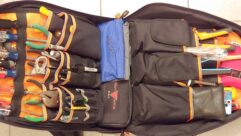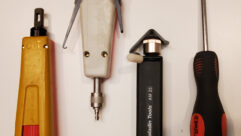TOOLS of the trade
Jul 1, 1998 12:00 PM,
Howard Friedman
Tools, or the lack of them, have likely been a problem for all of us at onetime or another. Probably, because we either forgot a particular tool, lostit, damaged it, wish we owned it or never knew it existed, our work wasdelayed, compromised or even jeopardized. Although having the right toolfor the job is a maxim many try to practice, maintaining this philosophycan sometimes be an expensive proposition. Nonetheless, experiencedinstallers and technicians will often tell of the satisfaction andenjoyment they experience when the right devices are at hand. Using theright tool always saves time, eliminates frustration and may create a morecost-effective means of getting the job done.
In this article, I’ll offer suggestions about adding to your existingcollection of tools and instruments so that they can be securitysystem-ready. As technology evolves, so too has the tool industry bydeveloping some clever innovations that you may find useful not only forsecurity installations, but also for all aspects of what you do. Some arequite common, others are unique, but all the devices mentioned shouldcontribute to your efficiency on the job. Even for companies consideredwell equipped, what follows may encourage the purchase of additional toolsand equipment to those you’ve already accumulated.
Circuit toolsWe know that today’s miniaturization makes it possible to get lots offeatures in a small package. Consider the use of a simple audible circuittester. Through a range of audible tones, it can indicate the presence of awide range of AC or DC voltages, continuity or an interruption incontinuity, making it possible to concentrate on a problem without havingto look directly at a meter. Better yet, it allows you to monitor acondition in one area audibly while being located at another. With a memoryfeature, the audible circuit tester can identify an intermittent conditionrelating to the presence (or absence) of either voltage or continuity. Thecondition can be annunciated in real time, or it can be stored for lateraudible (or visual) identification. To use the tester in this manner, itshould be installed at a convenient location and connected across theportion of a wire run or a voltage source that may be suspect. Should achange in the static condition be detected, no matter how brief, the testerwill record the event for subsequent retrieval. Because of its small size,it can be left unattended for long periods of time. Should an unexpectedcondition occur on a circuit, even momentarily, the tester will identifyand confirm it so the appropriate corrective action can be taken. There aremany similar testers on the market, and this feature may be incorporated insome digital multimeters (DMMs) as well. Alarm equipment distributors arevery familiar with this type of device because of the need to isolate andcorrect intermittent conditions (colloquially known as “swingers”) that mayresult in false alarms.
The loop stick has become a popular product, and its name has often beenused generically when referring to a device that dynamically locatesintermittent conditions in wire runs. The loop stick consists of a tonegenerator (mixing audio energy with a carrier wave) and a receiver capableof detecting that signal. In operation, the tone generator is connectedinto an unpowered circuit, where its wiring becomes the transmittingantenna for the tone. A possible flaw, either a potential short or an open,tapping, tugging or otherwise disturbing portions of the wire undersuspicion, causes the tone at the receiver to change noticeably as thehand-held receiver is moved along the run, revealing the location of dirtycontacts, tiny cracks in window foil or poor wiring splices.
Both the audible circuit tester and loop stick can be used to troubleshoota wide variety of security system problems, including tired or improperlyinstalled magnetic contacts, corroded foil take-off blocks and loosespring-loaded butterfly connectors, as well as dirty relay contacts, tamperswitches, junction blocks, pull-parts, terminal connections, splices,bell/siren circuits and end-of-line resistor connections.
Meters and instrumentsToday’s handheld digital multimeters (DMMs) enjoy great popularity becauseof their accuracy, small size, feature set and reliability. Autorangingmodels require only that the measurement function is chosen (for example,volts, ohms or amperes) without regard to the quantity being measured.Virtually all DMMs possess autopolarity, auto zero, superior overloadprotection and extremely high-resolution capabilities. Some havespecialized features relating to electronic components like checks fordiodes and transistors. Most are supplied with carrying cases, and some aredrop resistant and waterproof.
Hand toolsFor the proper mounting of control panels, PIRs and other alarmperipherals, a small 5 inch (127 mm) or 6 inch (152 mm) level can be usedto ensure that they are properly positioned. Pocket levels of this type aresmall and inexpensive and can easily be carried in a tool holster or shirtpocket.
For ease in drilling steel or aluminum, for creating starter holes to mountmagnetic contacts or for a wide variety of circumstances, a spring-loadedauto-punch will fit the bill. Although it looks like an ordinary hand-heldpunch, it is designed for easy one-hand operation. Pushing on it willautomatically create a small dimple in the intended surface, which iscapable of centering a drill bit. For hard surfaces, the pressure appliedby the punch can be easily adjusted.
Trying to start a screw in a hard-to-reach terminal strip or in a deepcrevice can be difficult, and even impossible, without some kind of devicefor holding a screw securely. Although magnetic screwdrivers have long beenavailable, sometimes something more reliable is needed. One end of a screwholder has a magnet for picking up dropped screws, while the other end hasa non-magnetic, screw-retaining fixture used for starting screws withauthority. Once done, the proper screwdriver can be used to finish the job.Although most of these devices are for use with slotted-head screws, thereare variations for Phillips-head screws as well.
Power toolsRechargeable cordless screwdrivers made their appearance shortly aftercordless drills became available. These are compact, lightweight, operatein forward and reverse modes and usually have an adjustable torque control.Those with an adjustable hinged handle can operate in either straight-lineor pistol-grip configurations. A quick-charging battery pack can often berevitalized in just one hour’s time, and coupled with a spare battery,there is no reason why such a tool should ever be out of service.Rechargeable screwdrivers come with a fair assortment of bits for mostpurposes. Because of its standard hexagonal chuck, a wide variety ofaftermarket bits can be used, including torx, allen and clutch head types.For the repetitive installation and removal of screws, particularly thoseof longer lengths, a cordless screwdriver can be a real time-saver. Be sureto get one with plenty of torque and a high capacity battery (along with aspare) when placing screws in tough material.
Special purpose toolsA popular tool available in many retail outlets is the stud sensor. Unlikethe older devices of the same name that used magnetism to detect thelocation of the nails driven into wall studs, this battery-powered sensoruses electronics and ultrasonic energy to sense variations in the densityof the wall as the device is moved from side to side to determine each edgeof the stud. Through its use, vertical studs can be located for selectingthe orientation of wire runs through the wall, or for mounting a heavycontrol panel. By the same token, the stud sensor can also be used tolocate the position of the horizontal studs (often known as fire blocks),which are often placed between adjacent vertical studs, before attemptingto run wires vertically behind the wall.
Another helpful hand-held electronic device is known as an AC voltage andmetal detector. Through its use, hidden cables, pipes and otherbehind-the-wall objects that can interfere with an installation can beidentified and avoided.
Drill bitsWhen running wires through inaccessible areas, long and flexible drill bitsare often required. Often ranging in several fixed lengths between 18inches (457 mm) and 72 inches (1.8 m), they can, with the aid of analignment tool, be aimed and steered in the proper direction and ultimatelyinto the desired area(s). The small opening at the tip of the bit allowsfor the withdrawal of a wire run through the drilled hole. For thickercabling, a recovery grip may be provided for placing the cable in a captivenetting. A swivel on the grip allows the drill bit to turn independentlyand permits relatively easy withdrawal when a slow reverse drill speed isused. Most flexible drill bits are available with either masonry, auger,combination or screw-point bits ranging between 1/4 inch (6 mm) and 1/2inch (13 mm) in diameter.
Wire-pulling toolsExtenzit looks like a walking cane and is 28 inches (711 mm) long at rest,but it can extend to about 8 feet (2.4 m) in five telescoping sections. Itis lightweight, made from fiberglass and has a reinforced hook at its endfor snagging wires and cables. Its applications are perfect for attic workwhere it would otherwise be necessary to crawl into low and inconvenientplaces. Similar tools known as Grabbit and Grabbit II-extending to 12 feet(3.7 m) and 18 feet (5.5 m), respectively-can be of use when extra longdistances are involved.
Fish wire is a must for any installation. It can be bought loosely coiledand cut to size, or it can be purchased in a self-contained retractablehousing. By cutting short lengths of the fish wire to which a wire run canbe attached, a firm but flexible method of routing wire becomes available,making it possible to pull it between different levels or rooms.
Both Fish-Eze and Fish Grabber are very useful tools when any kind of wireinstallation which spans two levels is required. Fish-Eze consists of twolengths of 1/4 inch (6 mm) stainless steel tubing, along with a 12 foot(3.7 m) length of fish wire. Typically, an inconspicuous hole is drilledbetween the two adjacent levels, and the desired length of tubing isinserted. Next, the fish wire is run within the tubing, allowing it to spanboth levels. An eyelet on the end of the fish wire can be grabbed by theExtenzit tool and retrieved into a more convenient area. The desired wireor cable is attached to the eyelet and then pulled within the tubing as ittravels from one level to another. The Fish Grabber acts like a giant weband can be used, when closed, to snag wire or fish tape.
Wiring devicesA rather common device introduced to the CCTV market about 15 years ago,the coaxial cable wire-stripping tool provides an easy, efficient way toaccomplish most coaxial cable-stripping jobs. Simply insert the cable, spinthe tool, and the blade design delivers precise stripping of outerinsulation, shield and inner dielectric on all brands and sizes of coaxialcable, including RG6, RG58, RG59, RG62 and other common sizes. Some unitshave accessories for the stripping of several sizes without going anyfurther. Other units come in a different size for each wire gauge.
A wide variety of tools are available for crimping insulated andnon-insulated terminals and splices in wire sizes between AWG #22 and AWG#10 . Terminal crimper tools have wire strippers and cutters included andcan even be used to cut common #4, #6, #8 and #10 screws to a desired size.Some tools of this type are equipped to cut equivalent metric screws up to5 mm.
Soldering ensures good electrical connections in unfavorable environmentswhere salt air, moisture and vibration may exist. When properly performed,soldering creates a mechanically strong connection that is forever sealedto the external elements. Lightweight portable soldering irons can becarried like pens, yet they can deliver power equivalent to a 60 W ironwith adjustable tip temperatures. There are gas-operated units that can befilled with ordinary butane lighter fluid and provide up to 60 minutes ofcontinuous use. Both butane-powered and battery-operated soldering ironsare readily available and should be a part of any installer’s tool kit.
Telephone-line accessoriesToday’s lineman’s handsets have reached a point of sophistication notcommonly found in earlier units. Most handsets can function as a phone linetester and line identifier, a line monitor and even a standard telephone.Each has a standard keyboard for entering numbers and is switchable betweenrotary and tone dialing. The better units usually contain speakerphonecapabilities, an elaborate set of alligator clips for making connectionsand the ruggedness to withstand the consequences of field service. A goodhandset can aid in making connections between a premises’s incoming phonelines and the RJ31X jack that interfaces with the alarm control panel.Handsets are desirable when troubleshooting installations that fail toestablish communication with the central station and, in this regard, arealso quite convenient when voice contact is required between an installerand the alarm monitoring facility. Most handsets boast a last number redialfeature, memory for storing important phone numbers and a mute switch foruse in noisy environments.
MiscellaneousThe need for cleanliness has always been apparent in alarm installations,and the impression made by your installers and their cleanup habits willoften affect future customer referrals. Today’s portable vacuums have beenused for years in many aspects relating to installation and servicing. Theyoffer powerful suction to pick up dust, wire scraps, small pieces ofplaster and unwanted debris. Many come with adjustable shoulder straps forease of handling and a long power cord to cover a wide area within thepremises.
Consider a portable extension cord featuring multiple grounded outlets anda 25 foot (7.6 m), 16 gauge power cord-all in a self-contained reel form.Rated for both indoor and outdoor use, a multi-use cord reel contains acircuit breaker that guards against overloads.
Portable two-way radios are ideal for installers who have to communicatewith each other from different locations in a premises without shouting.Most are built to survive the cruel and unusual treatment of the field, yetlight enough to carry by hand or in a pocket or belt holster. They usuallycome in single-channel VHF models and UHF models with multichannelcapability. VOX (voice-activated) models include a headset for hands-freeoperation and contain an external mic. Most models include an externalantenna jack, rechargeable battery and squelch control.
These and many other tools and devices have become popular in theinstallation field. Most alarm system distributors carry these products forthe convenience of their customers. They can also be purchased throughspecialty and tool catalogs, and may be seen when they are exhibited duringvarious security industry trade shows. Having and using the right toolswill help you avoid the inevitable frustration of being delayed because ofa forgotten or inadequate device. Here, in this column, we’ll continue tokeep you up to date with the latest developments in installation tools andequipment.










